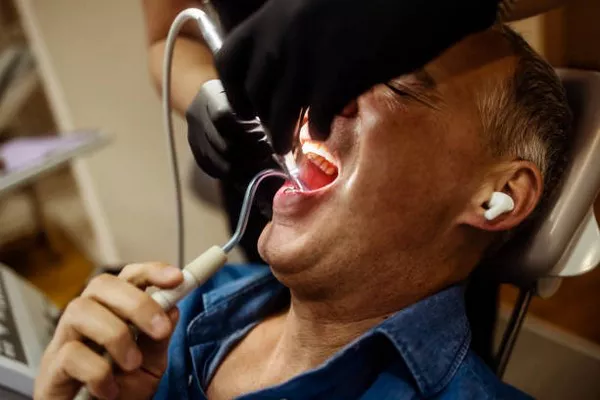Cavities, also known as dental caries or tooth decay, are a common dental problem caused by bacteria. They develop when bacteria in the mouth produce acids that dissolve the enamel, which is the hard outer layer of the teeth. This process, known as demineralization, weakens the enamel and creates small holes or cavities in the teeth. If left untreated, cavities can progress deeper into the tooth, causing pain, infection, and eventually tooth loss.
The primary culprits behind cavity formation are oral bacteria, particularly Streptococcus mutans and Lactobacillus. These bacteria feed on sugars and starches from food particles left on the teeth after eating. As they metabolize these sugars, they produce acids that attack the enamel, leading to decay over time. Factors such as poor oral hygiene, frequent consumption of sugary foods and beverages, dry mouth, and genetic predisposition can increase the risk of developing cavities.
Cavity Filling Procedure
When a cavity is detected during a dental examination, the most common course of action is to have it filled. The cavity filling procedure typically involves several steps to remove the decayed tooth material, clean the affected area, fill the cavity with an appropriate material, and shape and polish the filling to restore the tooth’s function and appearance.
- Removal of decayed tooth material: The dentist begins by administering a local anesthetic to numb the area around the tooth. This ensures that the patient feels minimal discomfort during the procedure. Using a dental drill or other specialized instruments, the dentist carefully removes the decayed portion of the tooth, leaving behind healthy tooth structure.
- Cleaning the affected area: Once the decayed material has been removed, the dentist thoroughly cleans the cavity to eliminate any remaining bacteria and debris. This helps prevent further decay and ensures proper adhesion of the filling material to the tooth surface.
- Filling the cavity with appropriate material: There are several types of filling materials available, each with its own advantages and disadvantages. The dentist selects the most suitable option based on factors such as the size and location of the cavity, the patient’s aesthetic preferences, and budget considerations.
- Amalgam: Amalgam fillings, also known as silver fillings, are composed of a mixture of metals, including silver, mercury, tin, and copper. They are highly durable and cost-effective, making them a popular choice for filling cavities in posterior teeth (molars and premolars). However, their silver color makes them more noticeable than other filling materials, which may be a concern for some patients.
- Composite: Composite fillings are made of a tooth-colored resin material that blends seamlessly with the natural tooth structure. They are versatile, durable, and aesthetically pleasing, making them ideal for filling cavities in visible areas of the mouth. Composite fillings require less removal of healthy tooth structure compared to amalgam fillings and bond directly to the tooth, providing added support.
- Gold: Gold fillings, also known as inlays or onlays, are made of gold alloy and are custom-fabricated in a dental laboratory before being cemented into place by the dentist. While gold fillings are extremely durable and biocompatible, they are also the most expensive option and require multiple appointments to complete the procedure.
- Glass Ionomer: Glass ionomer fillings are made of a mixture of glass and acrylic resin and release fluoride over time, which can help prevent further decay. They are commonly used for small cavities in areas with low bite pressure, such as around the gumline or in primary (baby) teeth. However, glass ionomer fillings are less durable than other materials and may need to be replaced more frequently.
- Shaping and polishing the filling: Once the filling material has been placed, the dentist shapes it to match the contours of the tooth and bite. This ensures proper function and occlusion. Finally, the filling is polished to smooth out any rough edges and restore the tooth’s natural appearance.
Preparation for the Procedure
Before undergoing a cavity filling procedure, patients should follow any pre-appointment instructions provided by their dentist. These may include:
- Maintaining good oral hygiene: Brushing and flossing regularly can help remove plaque and bacteria from the teeth, reducing the risk of further decay.
- Avoiding food and drink: Patients may be advised to avoid eating or drinking anything for a certain period before the procedure, especially if they will be receiving sedation or anesthesia.
- Taking medications as prescribed: Patients who take medications regularly should continue to do so unless instructed otherwise by their dentist.
During the Procedure
During the cavity filling procedure, patients can expect the following:
- Administration of local anesthesia: The dentist will inject a local anesthetic into the gum tissue near the affected tooth to numb the area and prevent pain during the procedure. Patients may feel a slight pinch or pressure during the injection, but any discomfort should subside quickly.
- Use of dental tools: The dentist will use specialized instruments such as dental drills, excavators, and handpieces to remove the decayed tooth material and prepare the cavity for filling. Patients may hear noises and feel vibrations during this process, but they should not experience any pain.
- Placement of filling material: Once the cavity has been cleaned and prepared, the dentist will fill it with the chosen filling material and shape it to restore the tooth’s function and appearance. Patients may be asked to bite down on a piece of paper or special articulating paper to ensure that the filling does not interfere with their bite.
- Final adjustments and polishing: After the filling has been placed, the dentist will make any final adjustments to ensure proper fit and occlusion. The filling is then polished to smooth out any rough edges and give it a natural appearance.
Aftercare
After the cavity filling procedure, patients should follow these guidelines for proper aftercare:
- Avoid chewing on the treated tooth: Patients should avoid chewing on hard or sticky foods for a few hours after the procedure to allow the filling material to set properly.
- Practice good oral hygiene: Brushing and flossing regularly can help prevent further decay and prolong the life of the filling. Patients should also continue to attend regular dental check-ups and cleanings to monitor the health of their teeth and fillings.
- Manage any discomfort: It is normal to experience some sensitivity or discomfort in the treated tooth after the anesthesia wears off. Over-the-counter pain relievers such as ibuprofen or acetaminophen can help alleviate discomfort. If the pain persists or worsens, patients should contact their dentist for further evaluation.
Cost Considerations
The cost of cavity fillings can vary depending on factors such as the type of filling material used, the size and location of the cavity, and the dentist’s location and expertise. In general, composite fillings tend to be more expensive than amalgam fillings due to their aesthetic appeal and the additional time and skill required to place them. Gold fillings are the most expensive option, primarily due to the cost of the precious metal itself.
Some dental insurance plans may cover a portion of the cost of cavity fillings, while others may require patients to pay out-of-pocket. Patients should check with their insurance provider to determine their coverage and any applicable copayments or deductibles. For those without insurance or limited financial resources, some dentists offer payment plans or discounted rates for cash-paying patients.
Long-Term Care
Maintaining good oral hygiene habits is essential for preventing future cavities and ensuring the longevity of fillings. This includes:
- Brushing teeth twice a day with fluoride toothpaste
- Flossing daily to remove plaque and food particles from between the teeth
- Limiting consumption of sugary and acidic foods and beverages
- Avoiding tobacco products, which can increase the risk of gum disease and tooth decay
- Visiting the dentist regularly for check-ups and cleanings
By taking proactive steps to care for their oral health, patients can reduce their risk of developing cavities and other dental problems and enjoy a healthy, beautiful smile for years to come.
Conclusion
Cavity fillings are a common dental procedure used to treat tooth decay and restore the structure and function of the affected tooth. By understanding the process of cavity filling, the different filling materials available, and proper aftercare guidelines, patients can make informed decisions about their dental health and take proactive steps to maintain a healthy smile.
FAQs About Getting a Cavity Filled
1. Is getting a cavity filled painful?
Many patients are concerned about experiencing pain during a cavity filling procedure. However, with modern dental techniques and anesthesia, the process is typically not painful. Before the procedure begins, the dentist will administer a local anesthetic to numb the area around the affected tooth. This ensures that you will not feel any pain during the cavity filling. While you may feel some pressure or vibrations from the dental tools used, any discomfort is usually minimal and temporary. If you experience anxiety about dental procedures, you can discuss options for sedation or relaxation techniques with your dentist to help you feel more comfortable.
2. What to expect when having a cavity filled?
When you have a cavity filled, you can expect the following steps:
- Numbing the area: The dentist will administer a local anesthetic to numb the area around the affected tooth.
- Removal of decay: Using specialized dental tools, the dentist will remove the decayed portion of the tooth.
- Cleaning the cavity: The dentist will thoroughly clean the cavity to remove any remaining bacteria and debris.
- Filling the cavity: The dentist will fill the cleaned cavity with an appropriate filling material, such as amalgam or composite.
- Shaping and polishing: Once the filling is in place, the dentist will shape and polish it to restore the tooth’s natural appearance and function.
3. How long does a cavity filling take?
The duration of a cavity filling procedure depends on several factors, including the size and location of the cavity, the type of filling material used, and the individual patient’s needs. In general, a single cavity filling can take anywhere from 20 minutes to an hour to complete. However, more extensive decay or multiple cavities may require additional time. Your dentist will provide you with an estimate of how long the procedure will take during your appointment.
4. Can you eat anything after getting a cavity filled?
After having a cavity filled, it’s important to wait until the anesthesia wears off completely before eating or drinking anything. This typically takes a few hours. During this time, it’s best to avoid consuming hot or hard foods and beverages, as well as anything sticky or crunchy that could potentially dislodge the filling. Once the numbness subsides, you can resume your normal diet. However, it’s advisable to start with soft foods and gradually reintroduce harder textures as your mouth adjusts to the filling. If you experience any discomfort or sensitivity, stick to lukewarm or room temperature foods and beverages and avoid extremes in temperature until your tooth has fully healed.
If you have any further questions or concerns about getting a cavity filled, don’t hesitate to discuss them with your dentist. They can provide personalized guidance and address any specific needs or preferences you may have.
































